Content
- 1 Botanical reference
- 2 Popular varieties and hybrids
- 3 Ground, indoor, greenhouse?
- 4 Eustoma in various climatic conditions
- 5 Basic growing guidelines and common mistakes
- 6 Reproduction of eustoma
- 7 Diseases and pests
- 8 Description of eustoma flower
- 9 Types and varieties of eustoma
- 10 Features of growing eustoma
- 11 Growing eustoma from seeds
- 12 Eustoma at home
- 13 How to grow eustoma in the garden
- 14 Eustoma care after flowering
- 15 Eustoma - description of the flower, cultivation features (video)
I often re-read collections on certain plants on the site and I see that some species are of great interest to readers. One of them turned out to be eustoma, or, as it is also called, lisianthus.

Many of us got acquainted with this plant as a cut crop - in bouquets. Eustoma, as they say now, is "in trend", and the fashion for it has been steadfastly holding for the past several years. And we, as the plant becomes more and more fashionable, try to delve into the growing process, with its mistakes and, of course, questions.
Botanical reference
The genus Eustoma (
Eustoma
Salisb.), According to most data, includes 3 species and belongs to the gentian family (
Gentianaceae
Juss.). Sometimes only 2 species are distinguished, the most popular of which is combined under the name large-flowered eustoma (
Eustoma grandiflorum
(Raf.) Shinners) or Russell's eustoma (
Eustoma russellianum
(Hook.) G. Don). The homeland of these plants is the south of the United States and further south, to the north of South America, as well as some islands of the Caribbean Sea.

A synonym for the name is lisianthus, which means "bitter plant". It is believed that the plant is not touched by pests, but this is a misconception. Also, eustoma is called the Irish rose, prairie gentian, Texas bell, tulip gentian. Most likely, a clear external resemblance to the queen of flowers gave impetus to the fashion for this most interesting plant, and gave rise to one of the classic combinations of a wedding bouquet.

Popular varieties and hybrids
Eustoma varieties and hybrids have flowers of purple, blue, pink, cream, white; sometimes colors are combined. Bell-shaped corolla; flowers are often semi-double, double, reminiscent of a rose flower. The leaves are bluish-green, waxy. The plant reaches 60 cm in height. There are F1 eustoma hybrids, the main advantages of which are greater resistance, earlier flowering. Also bred dwarf, fast-growing varieties.

A romantic and gentle variety of eustoma with lavender flowers Rosina lavender:

The unusual color of the petals distinguishes the Fringe mint green cultivar:
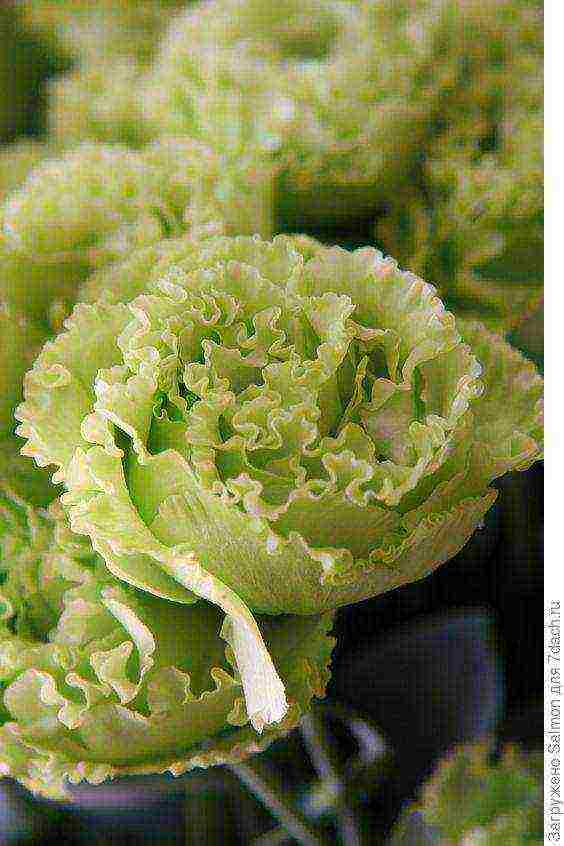
The next photo shows flowers of the Amber double marron variety:
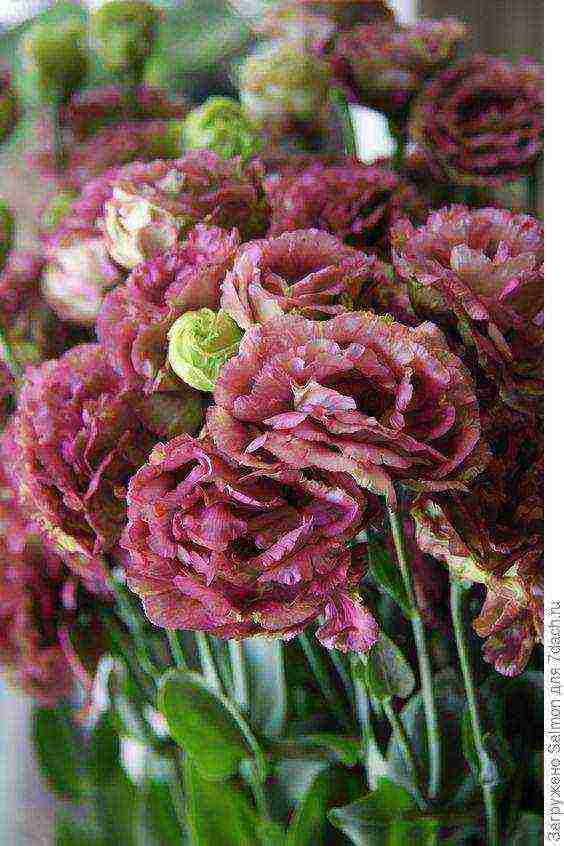
And the Beppin-San variety surprises with its unusual shape of petals resembling feathers:
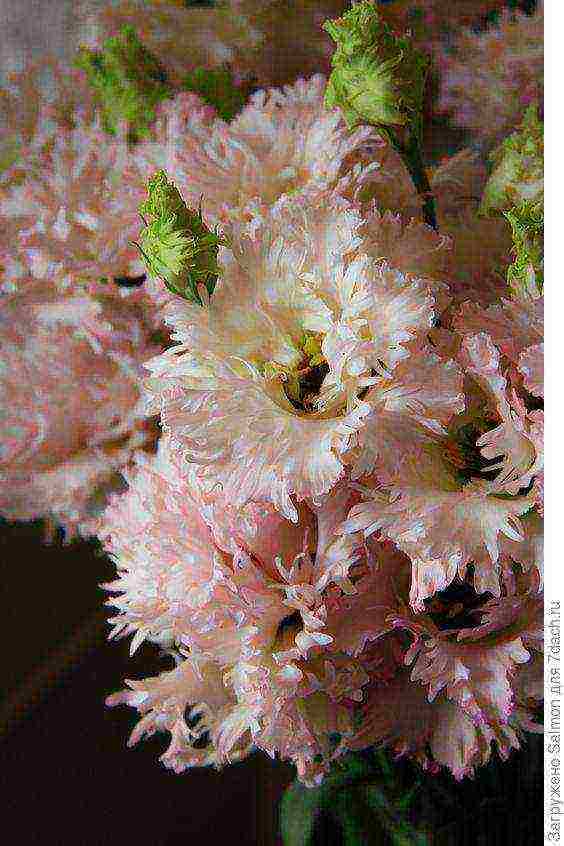
Ground, indoor, greenhouse?
Information about this plant is rather contradictory. They write that she is a perennial, annual, biennial; that it is extremely thermophilic - and that it is moderately resistant to slight frosts; some argue that it is easy to grow it, others that it is a task of average complexity. I think, as in all difficult issues, the truth is somewhere in between.
What is the reason for such contradictory data?
- Breeding achievements: breeders work with this plant constantly, and your impressions will greatly depend on what kind of eustoma you grow.
- A variety of conditions, their multifactorial nature: when they sowed, in what soil, what pot; how they planted; how it was dug up and in what conditions it was placed thereafter; how they covered, how they fed; what the weather was like and so on.
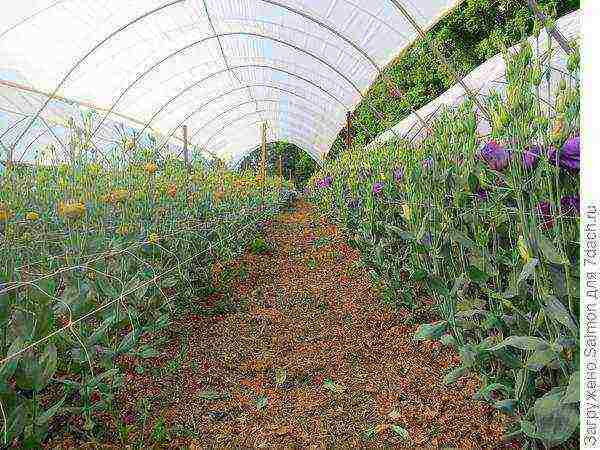
If we talk about the most likely cultivation options, then eustoma can be considered as:
- a perennial short-lived plant stored in winter (with preliminary pruning) in a cool room (basement, illuminated cool loggia, at + 5 ... + 10 ° С) or - in warm areas - with shelter;
- biennial (maximum three years) in the garden, with shelter;
- garden annual;
- cut or pot culture (in wide shallow containers) - in a greenhouse or room.
Eustoma in various climatic conditions
In the USA, for example, it is believed that eustoma can be grown in climatic zones 5-10 (average minimum temperature from -28.9 to + 4.4 ° C), and as a perennial in zones 9 and 10 (average minimum temperature from - 6.7 to + 4.4 ° C). Sometimes zone 11 is also indicated (up to + 10 ° С).

Compare with the climate of your area, and it will become clear a possible way of cultivation (albeit without options for additional plant cover). On the other hand, the specific conditions of a particular area can make their own adjustments. Microclimate, soil conditions, plant care - everything can affect the result. It may turn out that in your region eustoma is able to grow successfully - and in theory this is not its zone. Or, for example, over time, a new - more or less frost-resistant - variety or hybrid may appear that does not fit into the book scheme adopted today.
Basic growing guidelines and common mistakes
What does eustoma prefer outdoors? Surely she loves warmth and blooms especially well when the nights are warm. Therefore, it is not surprising that gardeners complain about poor flowering or lack of it outdoors.
She does not like wet weatherespecially when the whole summer period is damp. In the garden for her, the ideal place will be where a lot of light... And in hot regions, shade is desirable in the afternoon.
This plant has a shallow root, it
does not tolerate a transplant ... So it is worth replanting eustoma only in extreme cases and with extreme caution.
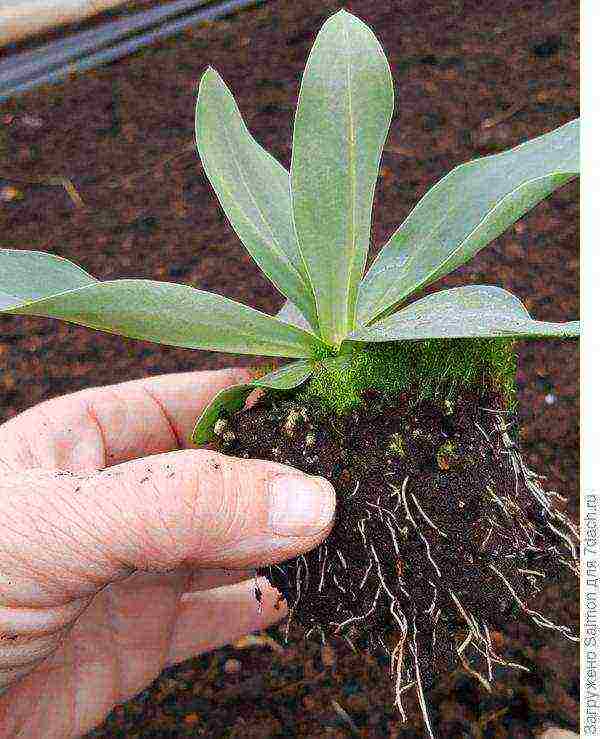
The soil
must be fertile, well-drained, with a reaction close to neutral or slightly alkaline. If you don't support
soil acidity
between 6.5 and 7.0, then the eustoma leaves will begin to turn yellow, their growth will weaken. Therefore, limestone must be added to more acidic soil.
In order for the eustoma to grow well, it must be water regularly and abundantly, keep the soil evenly moist. But it will successfully withstand short periods of drought. During flowering, the shoots with flowers are very bulky and can be damaged in the wind. In this case, they need props.
Reproduction of eustoma
Eustoma can be propagated both by seeds and stem cuttings in late spring or early summer.
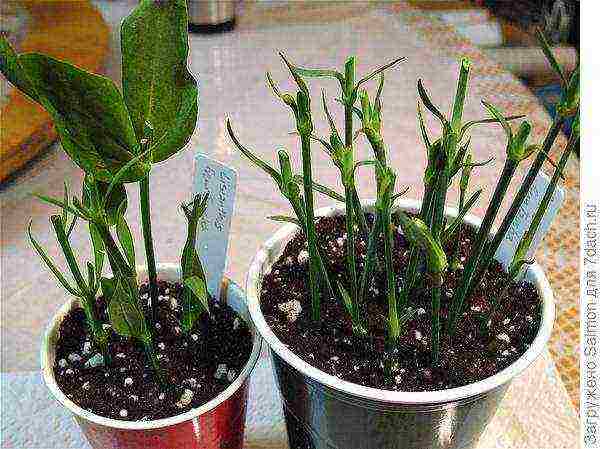
In warm regions close to the natural places of growth of eustoma, it is sown in the ground in early spring at a distance of 15-30 cm. Sowing in greenhouses is recommended in
peat pots or individual cells of the seedling cassette
, the acidity of the soil should be close to neutral.
Eustoma seeds for germination need light... They look like dust, so sow them on a damp surface and press lightly. Eustoma seeds in bags are often granular, so you can not be afraid to sow a lot of them in one pot. Germination lasts from 10 days to 3 weeks at a temperature of + 21 ... + 24 ° C (at lower or higher temperatures, germination may decrease), after the emergence of seedlings, it is better to lower the temperature to + 18 ° C. The night temperature should normally be + 16 ... + 18 ° C. It is advisable to lightly cover the seeds with glass or transparent film.

Young eustomas grow very slowly: after two months, they will normally have only 4 leaves. If, before the appearance of true leaves, the temperature is more than + 24 ° C, then the plant forms a low rosette form. The grown seedlings should be transplanted 3-4 plants into pots with a diameter of about 15 cm and placed in the lightest place.
However, it should be remembered that the plant may lack moisture in the sun, and this will affect the development of the leaves. So it is advisable to choose a place with bright diffused light or partial shading. It is believed that when growing seedlings, it is necessary to provide eustoma lighting for 8-12 hoursusing special lamps for supplementary lighting. And in industrial greenhouses, lighting is organized for 14-16 hours.
Eustoma seedlings require regular feeding... She is a real "glutton"; responds well to spraying with development stimulants (especially the root system). So do not forget about this feature of the plant - feed the seedlings often, you can little by little with each watering. At first, it is recommended to use nitrogen fertilizers, organic matter, apply fertilizing with calcium, and potassium and phosphorus fertilizers are desirable before flowering.
Particular attention should be paid to seedling watering regime: every few days, allowing the soil to dry out between waterings. You can periodically check the moisture content of the substrate at a depth of about 5 cm: if it is dry, we spray it from a spray bottle, slightly moistening the soil surface, but we do not change the watering regime (every few days). Please note: if you spray eustoma on buds or flowers, they can rot.
Seedlings are planted in open ground when it reaches about 15 cm in height, and only a few weeks after the last frost, when the temperature does not drop below + 5 ° C (in central Russia - at the end of May-June), gradually "accustoming" plants to new conditions.

In all eustomas, except for dwarf varieties, it is advisable to pinch the top so that the plant branches better. Sometimes, before flowering, it is treated with special substances (retardants such as daminoside), which improve flowering and help form squat bushes. Flowering is lush if the vegetative part (stem and leaves) is well developed, for which the seedlings need a sufficient amount of heat and light. It is believed that by removing old peduncles at the wilting stage not lower than the second pair of leaves, it is possible to stimulate re-flowering.
When to start preparing seedlings? Optimally - 10-12 weeks before the expected disembarkation with other normal growth factors. Flowering can occur 5 months after sowing. In our conditions, additional lighting is recommended in the initial period (approximately until March).
Diseases and pests
Most often, eustomas in our conditions are found:
- illness
fusarium wilting, gray rot, leaf spot, pitya root rot (pityosis), powdery mildew, viruses;
- pests
mushroom gnats, aphids, whiteflies, miners, slugs.
It should be remembered that pests are capable of transmitting viral diseases, so they should not be allowed to spread.
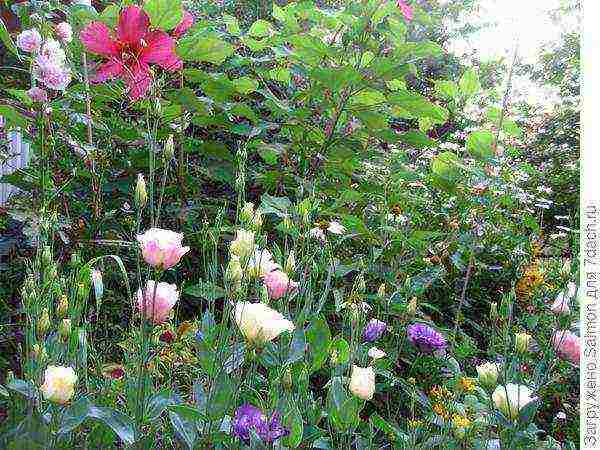
After planting in a permanent place, the plant should not be poured. If you keep the soil around the eustoma constantly moist, fungal diseases will immediately "attack" it. So mimic the prairie to your prairie beauty!
Do you already have eustoma growing? Or maybe there are plans to try to grow this wonderful plant?
In this article, I would like to tell you and show you what perennial eustoma is - planting and care, photos of buds and inflorescences that simply amaze with their different shades. This delicate and at the same time luxurious flower has many names. The plant belongs to the gentian family, its homeland is Central America, but it is also very widespread in South America, Mexico - wherever it is quite humid and warm at the same time. She does not like drafts and sudden temperature changes (and what flowers do they like, if you think so?).
Eustoma, photo:

As for the names, they are no less attractive than the flower itself - "Irish rose", "Texas bell", "tulip gentian", "prairie flower". And yet, despite the fact that this botanical name of this genus is considered rather outdated, eustoma is also called lisianthus, which in Latin means “bitter flower”. Since this representative belongs to the gentian family, it is easy to draw parallels. Moreover, the plant itself contains many bitterness, such as gentianin, genseopicrin, genciamarin and other similar derivatives.
On the Internet, on the relevant flower forums and in groups, you can often come across the following question: eustoma and lisianthus - what is the difference? The answer is predictable - there is no difference, this is the name of the same plant.

If we briefly go into the details and origin of the names, then Eustoma - from the Greek "Eu" means: "beautiful", "beautiful", and the same Greek word "Stoma" - means "mouth". As a result, we get a "beautiful mouth" or "lovely mouth" - whichever you prefer.

It is interesting that in each country this flower is called in its own way: in Ireland - an Irish rose, in Japan - a Japanese one, in Mexico - it is generally called a Texas bell, in France - a French rose of love. Be that as it may, these poetic names correspond to reality and once again demonstrate the sympathy of many nationalities for this amazing flower.
↑ to content ↑ Features of the eustoma flower
It differs not only by names, but also by the colors of the buds, the shape of the flowers themselves. Representatives of a particular variety essentially resemble a rose. A person far from the world of floristry can even confuse them. Certain varieties resemble in size and shape poppies, terry mallows, and some members of the lily family. Lisianthus stems are most often massive (like, for example, a carnation), it is noteworthy that one shoot can accommodate 20, or even 30 flowers (and sometimes even more!).

Eustoma - photo of flowers:

The leaves of the plant are not particularly distinguished, they are medium in size, slightly elongated with a sharp tip. But the color scheme of colors, as already mentioned above, simply amazes with its multicolor. Red, blue, cream, snow-white, lilac, two-color - with a transition from one shade to another, pink, lilac, yellow - any shades can be eustoma-lisianthus! With its exquisite beauty, this flower can compete with the bride's bouquet - and it's not in vain! In addition to their visual appeal, these flowers are very durable when cut. Various celebrations, banquets are often decorated with her bouquets, decorative arches are made out. And all because they can not lose their freshness and beauty for 15 or 20 days (naturally, being in water or in a special wet floristic sponge).
Irish rose differs in size, stem height. For example, depending on the variety, it can grow in the open field, in a greenhouse, in a pot on a windowsill at home (the so-called dwarf varieties). In its natural growing environment, this plant is a biennial, however, if you want to grow it in your summer cottage, count on the fact that you will have it as an annual. But potted versions of lisianthus are perennials.
Thus, perennial eustoma can exist exclusively in the home (apartment) version. The same factor applies to the length of the stems - tall representatives go to decorate bouquets and all kinds of decorations, and undersized lisianthuses delight your eyes at home, on window sills and flower shelves.
Lisianthus, by the way, is not quite capricious in cultivation and care. He will not require any special "dances with tambourines" even from a beginner-grower, both at their summer cottage and at home. Naturally, if you treat this matter with interest and care, do not forget about watering, adhere to simple rules and recommendations of experienced florists or neighbors in the country, where it successfully grows and blooms.
↑ back to content ↑ Some popular varieties and types of eustoma
The main differences between these colors, of course, consist in the external difference of each variety, in colors and shades, a variety of forms. On flower forums, you can most often find references to the varieties listed below. I would also like to show them here.
Eustoma large-flowered Russell (Eustoma russellianum).It has a straight stem, the bud itself is somewhat similar to a poppy (in shape), the petals can be with or without fringe. It can have completely different shades of buds.
Eustoma Russell, photo:

Lisianthus Echo is probably the most common variety for bouquets. It can reach a height of 60 cm, and the color range of the buds has approximately 11 shades, both monochromatic and with a gradient (one shade, smoothly turning into another).
Echo variety, photo:
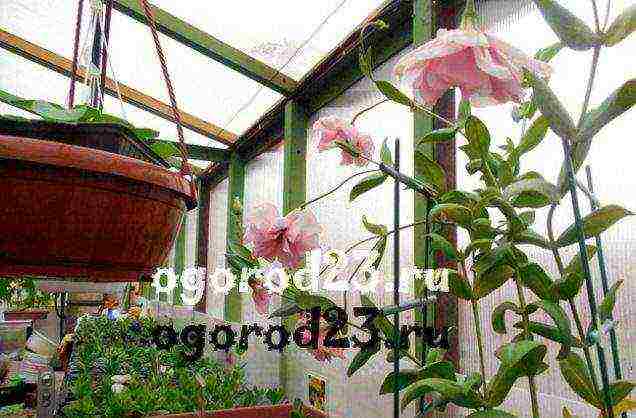
Lisianthus Aurora (Aurora) - an early cultivar, reaching 1.5 m in height, double flowers, saturated pink, snow-white, blue shades.
Eustoma Aurora, photo:

The Flamenco variety is a highly decorative species of Lisianthus, also reaching a decent height (approximately 1.3 meters). It is very unpretentious to care for and also boasts a multicolor bud.
Flamenco variety, photo:

Florida Pink has pink flowers! At least here it is not difficult to get lost in the bright variety. This is a perennial, the shoots of which are abundantly covered with flowers.
Lisianthus Florida Pink, photo:

The variety "Mermeid" is a potted species with a stem height of up to 15 cm. It is presented in a predominantly blue-violet range (mermaid-sea associations), but sometimes pink and white representatives are also found.
Mermeid variety, photo:

The Little Bell variety may seem rather simple in appearance, especially against the background of some lush fellow tribesmen, but this is precisely its charm and touchingness. It is also suitable for potting.
Lisianthus Little Bell, photo:

White Large-flowered (Lisianthus grandiflorum) is probably one of the most impressive varieties. This is exactly the eustoma from which wedding bouquets are made and with which they decorate the interiors of banquet halls. A very impressive and luxurious variety.
Lisianthus grandiflorum, photo:

In fact, there are about 60 varieties of this flower in nature, all of them are at the same time somewhat similar, but at the same time, they are completely different in appearance.
↑ to the content ↑ Features of growing eustoma in the garden, collecting seeds
In order for this beauty to feel comfortable and bloom in a violent color on your site, you need to decide in advance on the landing site. It should be sunny, and the soil on it should be fertile. Watering lisianthuses should be done as the upper layer of soil dries up.
Top dressing and fertilization is a matter of course, as in the case of any flowering garden dweller. This flower should be fertilized when it is already firmly rooted in a new place, this happens about a month after the seedlings are transferred to the flowerbed (in open ground). According to experienced florists, lisianthus prefers special complex preparations, similar to those recommended for the vast majority of their flowering counterparts.
How to grow eustoma? Top dressing "Plantafol Growth" or simply "Plantafol" is applied at the very beginning, when the flowers require fertilizers with a high concentration of nitrogen. When they begin to form buds (about mid-summer / August), you can begin to add Plantafol Budding to the root - it contains much more phosphorus than nitrogen. Preparations "Kemira" or "Kemira Lux" will contribute to a longer and more luxuriant flowering. The main thing - do not forget that all such additives must be diluted with water. And, one more important nuance, which is not indicated on the fertilizer package, but is strongly recommended by experienced flower growers - dilute a slightly lower concentration of fertilizer in water than is written in the instructions for use!
The Irish rose begins to bloom in mid-summer (in July) and continues to delight the eyes with lush buds until mid-autumn (until about October). As mentioned above, this flower is quite "tenacious", both in cut and in natural form - lisianthus inflorescences on one shoot may not fade up to 2 months.If you carefully cut the twig, it will grow back and be covered with new flowers. The duration of flowering also depends on the growing region: the warmer it is in your area, the longer it will bloom. For example, in our Kuban lisianthus will bloom for a long time and will repeatedly give new buds!
Eustoma - photo of flowers:

↑ back to contents ↑ How to collect eustoma seeds
Now let's get to the more serious part of the growing process - collecting seeds and further manipulating them. The seed pods of the flower are formed after pollination. In the open field, of course, plants are pollinated by insects. If you are breeding Lisianthus at home, then solving this problem with an ordinary (soft) brush will not be difficult and will not take much time. As with other flowers, seed pods remain in place of dried buds that have not been removed from the shoots.
Planting eustoma with seeds almost always has a positive result. The seeds sprout pretty well, both those that you managed to collect yourself and those that were purchased from the flower shop.
They are very small in size, those that are sold in the store are already "rolled up" in a special thin shell, which consists of components that promote better plant germination and growth. It is most convenient to stock up in advance with special cassettes for seedlings, and even better - peat tablets! In these tablets, the soil mixture has already been selected with a competent calculation of the composition, and it is much more comfortable to plant these tablets later in the open ground. And there - see how it is more convenient for you.
Eustoma seeds, photo:
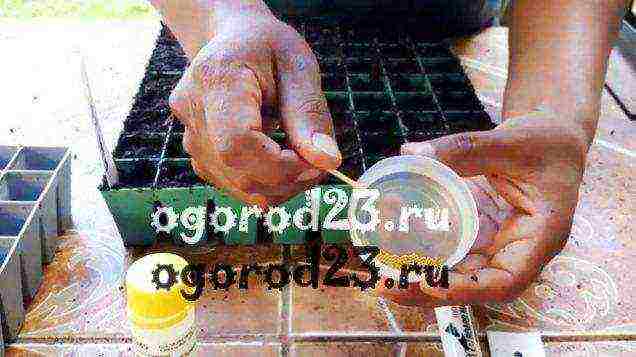

Both purchased store-bought and self-collected seeds are most conveniently buried in the soil with a toothpick, as shown in the photo above. Seeds are sown in winter or at the very beginning of spring - most often in February or early March, but there are also frequent cases of successful planting in January.
↑ to content ↑ Eustoma - growing from seeds
As mentioned above, for convenience, saving time and effort, you can buy peat tablets, you can also buy a ready-made soil mixture in a flower shop (the one that is designed for planting Saintpaulias or violets is perfect).
At the same time, you can approach this process in detail and make up the soil mixture yourself. At the time recommended for sowing, take a light garden soil that should pass water and air well. It should be clean land from a garden plot (without any plant residues or stones), peat and calcined river sand. Put all these components together in equal proportions. Additionally, you can add a couple of tablespoons of wood ash.
To play it safe and be sure that the sowing will be done in a clean earthen mixture, decontaminate the soil - this can be done by spilling the soil with a solution of potassium permanganate or steaming (not roasting in the oven!) a quarter is filled with water, put on fire. From above, earth is poured into a colander and covered with a lid on top. The whole process takes about 1 hour. The hot steam from the water flows through the holes in the colander and kills any bacteria in the soil. However, this method has one drawback - with harmful bacteria, beneficial microorganisms can also be destroyed that help resist future plants. In any case, the choice is yours. Subsequently, the steamed soil will have to be saturated with useful biofungicides, such as "Fitosporin" or, for example, "Trichodermin", "Baikal M1".
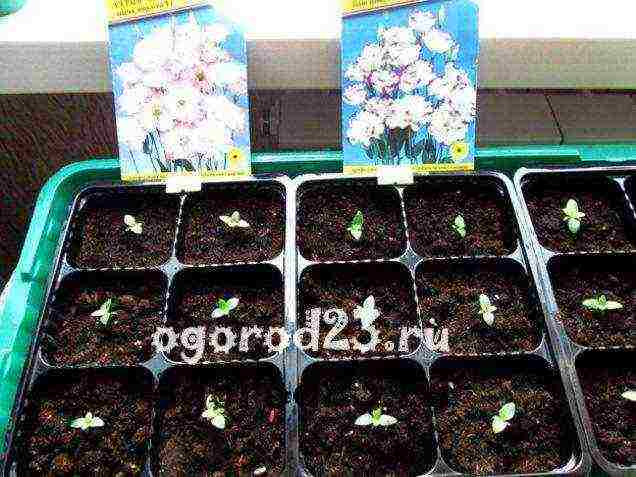
It is also extremely important to consider that sowing should be done only in disinfected containers! It can be like cassettes for seedlings (you can see them in the photo above), ordinary plastic or paper cups. Drainage holes are required for any containers you choose.Not only the soil mixture, but also the pots must be treated with appropriate disinfectant solutions. Even the container for peat tablets should be decontaminated as well.
How eustoma is planted with seeds:
- We take containers and fill them with a moistened earthen mixture.
- We put the seeds on top (you can use a toothpick or a sharply sharpened match - for convenience), do not deepen it much, just press it a little into the soil.
- Sprinkle with water from a spray bottle.
- We cover the containers with plastic (or thin food) film so that it must transmit light.
- Then the seedlings are transferred to a bright, warm place with an average air temperature of + 20 .. + 25 ° C. Advice - a south window is perfect for this. Sometimes it happens that the usual daylight hours are not enough for the harmonious development of plants. In this case, fluorescent lamps will come to your aid (i.e. additional illumination of seedlings). It is important that the plants do not start to stretch out from the lack of light!
- Once a day, briefly lift the film and ventilate the seedlings, along the way, gently moistening the soil with a spray gun.
- With the onset of night, you can move the containers to a cooler room, but with a not too significant temperature difference - this is not a prerequisite, but with the right approach it will not be superfluous.
If you do everything right, then the first small sprouts will appear in 10-12 days. After the eustoma-lisianthus has shown itself to the world, the protective film should be removed, irrigation should be moderated, the containers with plants should be transferred to a cooler room - with an air temperature of about +15 .. + 18 ° C. This flower is gaining growth slowly, the first true leaves appear after about a month and a half. By this time, it is already worth thinking about diving, although it is usually done two months after sowing.
Eustoma seedlings in the photo:

About diving:
- Before diving, water the soil in containers with plants.
- The fact is that even one seed can give 5 or 7 shoots, therefore, at a given time (2 months), the best, strongest representatives are selected, after which it should be very carefully, using a suitable miniature object, to remove the sprouts from the ground, and then transplant in individual pots or, again, in cups.
- Do not forget about drainage - pour a thin layer of fine expanded clay or even foam balls on the bottom of the pot.
- Deepening in the soil mixture can be done using an ordinary pencil, and the "operation" of the transplant itself using a metal manicure spatula, for example.
- Lisianthus seedlings have a very delicate root system - remember this always, not only at the time of transplanting.
- In the process of diving, bury the plant in the ground up to the very leaves.
- After that, it is advisable to place the containers with flowers in a shaded place where the air temperature will be about +18 ° C.
In most cases, lisianthus tolerates the picking process very comfortably, so the adaptation period in a new place is successful and the plant begins to grow rather quickly. After two or three months (as the weather in your region will allow), the Irish rose is transplanted to a permanent place of residence - either in a room pot, or on a flower bed, a summer cottage. This must be done carefully, by the transshipment method, together with the earthy lump - there is nothing new here. For this process, it is better to choose late spring / early summer, when any frost is 100% excluded.
Lisianthus after a dive, photo:

↑ to content ↑ How to grow eustoma in peat tablets
If we pay attention to the method of planting Lisianthus in peat tablets, then, I repeat, it is undoubtedly more convenient in all respects. Just take tablets of the appropriate size - for this plant you need a "circle" with a diameter of at least 5 cm.Further, I think, you will figure it out according to the instructions - the tablet is moistened with water at room temperature, swells to the required size, excess water is removed. The seed with the help of tweezers or a toothpick is placed in a specially designed hole, slightly pressed, and irrigated with water from a spray bottle.
Eustoma - cultivation in peat tablets, photo:
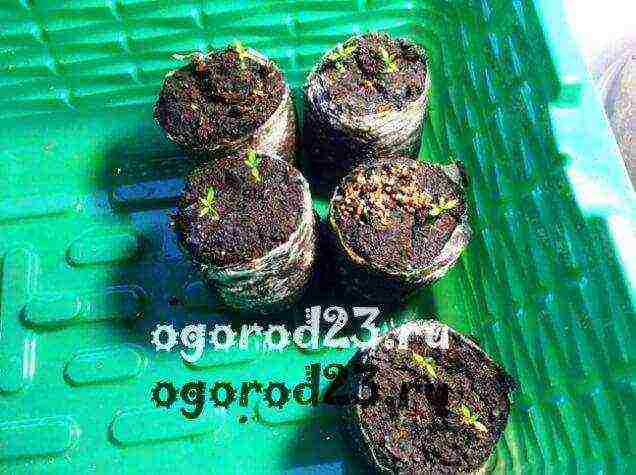
Then, too, everything goes as usual - covering with a film (creating a kind of greenhouse), airing, placing in a warm and bright room. Everything is the same as in the case of planting in soil. But when the first small leaves appear, immediately put the pill in a plastic cup. Thus, the roots will not intertwine, and each Lisianthus will be in its place.
↑ to the content ↑ Eustoma lisianthus - we plant it in the ground
We already know that it is preferable to choose an unshaded place on the site. About the absence of winds and drafts - too. For planting in open ground, choose a cloudy day or evening after sunset. The month is May or June, when sudden cold snaps will definitely not come. To release the plant from the pot, we use the transshipment method (remember the delicate root system of the eustoma). The distance between the bushes should be approximately 20-25 cm.
An Irish rose lisianthus is placed in a previously prepared hole along with a lump of earth, lightly sprinkled with soil and carefully squeezed. The hole itself should correspond in size to the size of the pot in which the flower grew. Its volumes should freely accommodate the extracted plant along with an earthen clod. By the way, additional protection of Lisianthus at the beginning of life "on earth" will not be superfluous - on a sunny day, cover the bushes with glass jars or cut plastic bottles. Eustoma blooms regardless of which month of winter or early spring you sowed the seeds. Around the middle of summer, in July, you can see the first flowers of this delicate and graceful flower.
↑ back to content ↑ Perennial eustoma - root planting
Due to the fragile and vulnerable root system, this plant cannot be propagated by dividing the bush into fragments or by cuttings (they do not germinate). As a last resort, ready-made seedlings can always be purchased in the appropriate flower shops. It reproduces only by sowing seeds, by growing seedlings - and nothing else. Lisianthus roots do not tolerate replanting, any sudden or incorrect movement can ruin the plant!
Sometimes it happens that novice growers under the concept of "Perennial Eustoma - planting by the root" mean precisely the division and subsequent planting of separated roots. Here it is necessary to clarify this small misconception, under the phrase "planting by the root" is often used the usual action of transferring a plant into open ground with a "native" earthen lump and, naturally, roots formed in it. These two concepts should not be confused.
↑ to the content ↑ Eustoma - when to sow seedlings in apartment conditions?
To grow this flower at home, sowing seeds can be done whenever you want! Eustoma seeds are tugovidny, so it is better to sow them on the growing moon. Suitable dates can be viewed in the moon phase calendar by month.
The main thing is to remember all the nuances, temperature conditions, backlighting (especially in winter) - and you will succeed. For potting at home, low-growing (dwarf) varieties of Lisianthus are used. The plant will feel more comfortable on those windows that face the east or west side. Bright, slightly diffused lighting is what is needed for a room eustoma, but on the south window, especially at noon, it is better to arrange light shading. It is highly likely that on the north window the Irish rose will not be able to develop harmoniously and may wither away from lack of sunlight.If you purchased a ready-made flower in a store, give it time to adapt, do not expose it immediately to direct sunlight, so that the leaves and flowers do not burn.
Make sure that when watering the water does not get on the flowers and buds, otherwise decay will not take long. In general, when watering, try to adhere to the golden mean - do not let the soil dry out, but also do not overmoisten it too abundantly. The optimal soil condition for irrigation at home is the formation of 1.5-2 cm of a dry upper layer of soil mixture in a pot. There should always be drainage in containers for a given plant; fine gravel, clean disinfected small pebbles or fine gravel can be placed on the bottom. In general, according to observations, homemade eustoma-lisianthus gives flowers best and feels comfortable in a slightly cool, well-ventilated room.
↑ to the content ↑ Caring for eustoma - recommendations
Adding to the above, we can recommend preventive irrigation procedures with special agents containing fungicides. Preparations "Topaz", "Saprol", "Topsin" will protect the plant from powdery mildew, fusarium, leaf spot, gray rot. Unfortunately, it is difficult to protect yourself from pests if the flowers grow outdoors. The main enemies of eustoma are whiteflies, slugs, aphids, miners, mushroom mosquitoes - such drugs as Mospilan, Aktara, Confidor and the well-proven Fitoverm successfully fight against these parasites.
Remember the love of Lisianthus for light and light shade, the east or west sides of the site are the best places for its growth. Water it sparingly, but regularly, do not wet the foliage when watering, so as not to provoke the appearance of gray mold and harmful fungi. Irrigation is no longer necessary for an adult flower, and water for irrigation, ideally, should be soft or settled. When the air temperature drops, the volumes of water for irrigation should be reduced. Sometimes, after planting in the ground, some gardeners recommend covering the plants with large plastic cups or cut plastic bottles for the first couple of weeks. This is recommended for the adaptation of the flower, getting used to a new place of residence, protection from drafts and winds, as well as to retain moisture in the upper layer of the soil.
After the eustoma-lisianthus fades, it begins a dormant period, life processes slow down and the plant seems to "fall asleep", stops growing. By this time, fertilizers should be completely eliminated, watering should be minimized, in a word - to give the flower a rest. In order for the Irish rose to delight you with its splendor next year, be sure to cut off all the branches, leaving at most two or three main points of tillering (branching).
↑ to the content ↑ Eustoma - growing, summing up
Wherever she grows up, she needs to create a comfortable environment. On the plot or at home, in the room - it should be good, then it will bloom and smell, please you with a healthy look. This plant is capable of producing peduncles throughout the entire flowering period, if the shoots are not cut at the root. But in warm regions, even such radical pruning can lead to the re-development of stems and flowers on them.
Perennial tall eustoma will decorate your site and the surrounding area, it will harmoniously combine with other flowers and shrubs, will remain fresh for a long time and will perfectly tolerate transportation in a cut form, if the situation requires it. Low-growing varieties will become a bright decoration of your home, balcony, window sill.
It must be remembered that the Irish rose is a plant that will inevitably wither away without moisture. Drying out of the soil should not be allowed in any case. Excessive waterlogging will also not lead to anything good - the plant will begin to ache, the roots may rot.Plowing the ground around the flower should be done carefully (remember the delicate roots), we naturally remove the weeds.
Reading, getting acquainted with all the nuances, it may seem that this is too troublesome business, and the lisianthus eustoma itself is a capricious and characteristic plant. In fact, this is not at all the case, any green inhabitant we cherish and cherish requires attention and care, sometimes individual. Trees, shrubs, any plants and flowers are creatures of nature, they are alive and also need comfortable living conditions. And the beautiful eustoma is not so different in terms of avoiding her neighbors with roses, fragrant hyacinths, surfinias and other decorations of our gardens and plots. There is hardly a florist or summer resident who does not like perennial eustoma with its delicate beauty, planting and care, photos of various varieties and shades will not leave anyone indifferent!




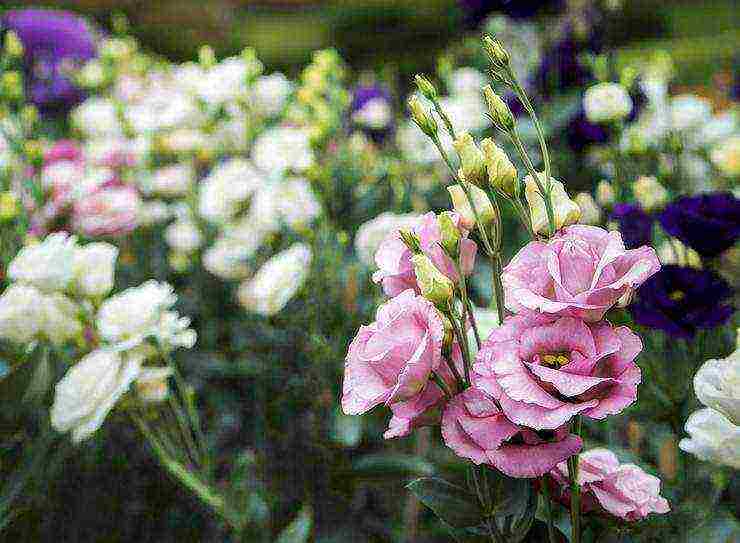
Eustoma or Lisianthus is a herbaceous annual or perennial plant. Eustoma belongs to the prominent representatives of the gentian family. Initially, its habitat was considered to be the territory located in the south of North America, Mexico, the north of South America, and the plant was also found on the islands of the Caribbean.
The translation of the name of the flower Eustoma from the Latin language means "beautiful mouth" or "beautifully speaking". Native Indians invented a legend that tells of his appearance. Once, after the death of a girl, an unknown flower bloomed at the site of her grave. The ancient story says that the girl fell victim to the spirit of war. He severely punished her for disobeying and refusing to offer marriage. In Europe, the plant became known thanks to the doctor and scientist Patrick Brown, who was born in Ireland.
Among experienced florists, it is especially popular both for growing in the garden and at home. Cut flowers can be stored like this for about three weeks, while retaining their attractiveness and freshness. In artificial conditions, the plant began to grow in the last century.
Description of eustoma flower
Strong and graceful stems resemble carnation stems in their structure and can reach a height of about a meter. The branch looks like a real bouquet due to the excessive branching of the stems. The number of buds on one branch fluctuates about 35 pieces, which bloom, replacing each other. The leaves, gray or bluish with a matte finish, have an elongated oval appearance. Large flowers are funnel-shaped, cups are 5-8 cm in diameter. There are pink, lilac, white and purple buds. They can be the same color or have contrasting edging around the edges of the calyx. The half-open flower slightly resembles a rosebud, and the fully open one resembles a poppy. Eustoma growing in its natural habitat is considered a biennial plant. The horticultural period only takes one season. In a flowerpot, she can live for about 4-5 years, and for open ground, her life span is reduced to several years.
Types and varieties of eustoma
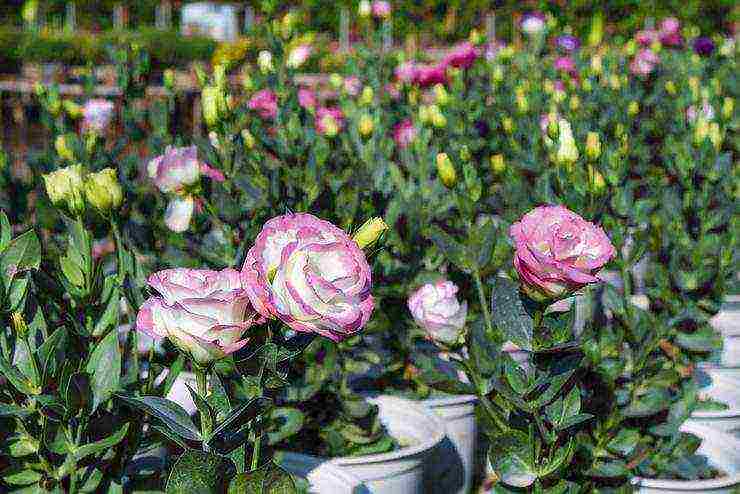
Today, about 60 species of eustoma are bred. The indoor variety is called Russell's eustoma, and a large-flowered crop is used for garden cultivation. Some of the florists do not even distinguish between these types. To date, there are still disputes between them on this issue. However, for convenience, we will still highlight the main varieties, depending on the purpose. For example, in order to cut a flower and further use it in bouquets, tall crops are bred. The stems of indoor plants reach a height of no more than 45 cm.
Tall eustoma varieties
- Aurora has blue, white, blue or pink buds and early flowering.
- Echo reaches a height of 70 cm, has spreading stems and large buds. 11 color varieties of this variety are grown.
- Heidi reaches a height of 90 cm, is characterized by frequent flowering.The variety has 15 color varieties.
- Flamenco - the highest and picky variety, which can reach 90-120 cm. Large flowers have many shades.
Indoor varieties of eustoma
- Mermaid - a low, branched plant, stems 12-15 cm long, small flowers can be white, blue, pink or purple in color.
- Littlebell reaches a height of 15 cm and does not need a clothespin, has simple funnel-shaped cups of various shades.
- Eustoma Loyalty - a white flower up to 20 cm high, on which numerous simple buds are spirally located.
- FloridaPink - a variety that has pink flowers that form a bouquet of the correct shape.
Features of growing eustoma
- Eustoma should be planted in sunny and open areas of the garden.
- The soil for planting is a prepared mixture of peat and humus.
- The plant is grown using seeds. Cuttings are unable to reproduce because the root system is very fragile and does not divide.
- The plant can only be watered if the surface of the substrate dries out, since it does not tolerate excessive moisture.
- After the plant gets stronger and begins to bloom, do not transplant it elsewhere. The roots will not be able to take root in foreign soil and will simply die.
- At home, flowerpots should be stored in a cool and well-ventilated room.
Growing eustoma from seeds
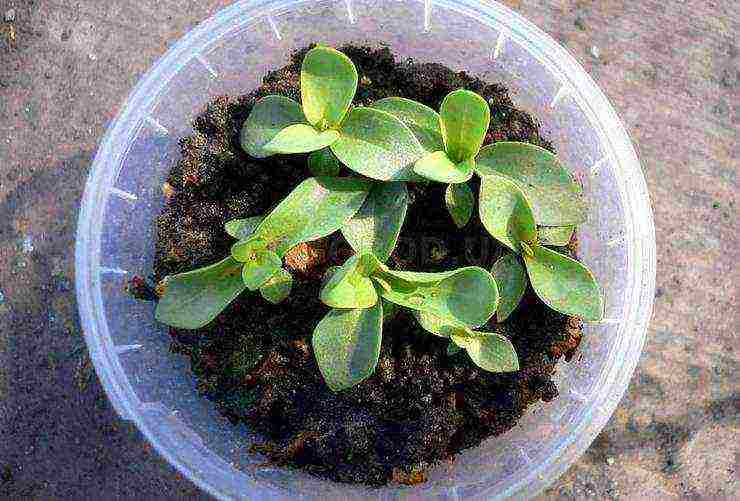
Growing a full-fledged strong plant at home is a rather difficult task even for experienced flower growers. Such a laborious and long-term process will surely bear good results. Today, among many garden and indoor crops, eustoma is gaining more and more popularity. To begin with, it is worth noting the fact that the main reason for difficult cultivation is the small seeds of this plant. Before planting begins, they are subjected to a special treatment that allows them to achieve high yields. The seeds have a low germination rate. Only 60 of 100 seeds can take root, and the rest will die.
Horticultural crops begin to be cultivated in February or March. Planting this early will ensure flowering in July or August. A prepared sterilized substrate is used as a soil, which is distinguished by a low amount of nitrogen in its composition. The scattered seeds should be lightly pressed against the soil and covered with plastic wrap or glass to keep the soil surface from drying out. To ensure easy ventilation of the air, it is required to provide small holes. Planted plants need additional lighting, so electric lamps are installed above them. The ideal daytime air temperature for seed development is considered to be at least 20 degrees, at night it should not drop below +14 ºC. To maintain constant soil moisture, regular spraying is necessary. Subject to all the conditions for the correct cultivation of this culture, the first green shoots should appear in two weeks. Young shoots must be constantly sprayed with Fitosporin solution. After a month and a half, several pairs of leaves are already formed. The next stage of growing the plant will be to transplant it into pots, and after 3 months the grown seedlings are transferred to open ground.
Eustoma at home

To decorate an apartment in winter with bright and interesting colors, it is necessary to sow seeds from July to September. To do this, you need to fill the planting container with a wet substrate, which includes an equal amount of sand and peat, and scatter seeds over it. The prepared containers are placed in a warm and bright place, remembering to regularly spray the soil.
When the first green leaves appear, watering is halved so that the soil surface can dry out slightly between them. Then watering is carried out exclusively in the morning.As soon as two pairs of leaves appear on the shoots, the plant is planted in pots.
Indoor varieties are quite moody flowers that require constant lighting and oxygen access. In the room, it is necessary to maintain an air temperature of 19-22 degrees, and also do not forget to ventilate it regularly. Watering is not done too often. The water must be settled. The leaves do not need to be sprayed so as not to provoke any diseases. Plant feeding begins with the formation of buds and the rapid growth of stems. Liquid complex fertilizers can be used. Compliance with all conditions will ensure healthy development of the eustoma and re-flowering in a few months.
Details about growing eustoma at home
How to grow eustoma in the garden
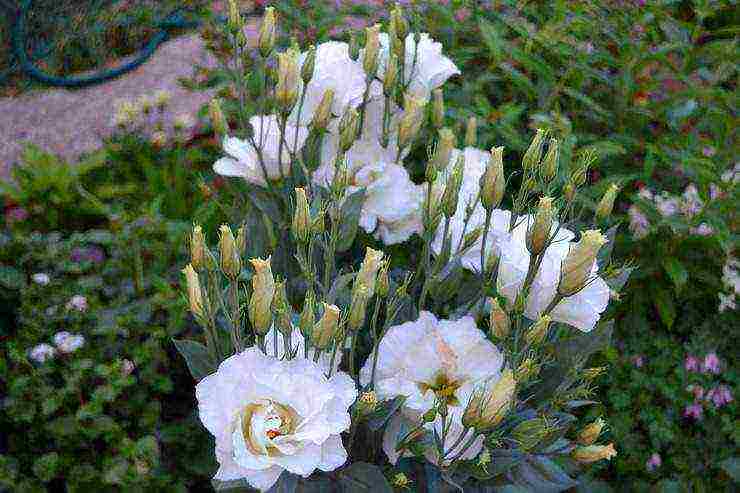
Horticultural crops are grown from seeds. Sowing is done in December-January, in this case the first flowers will appear in June-July. As a container for sowing, an excellent option will be low plastic cups, which are filled with the prepared substrate. Seeds are placed in them and covered with foil on top, creating artificial greenhouse conditions. It must be raised periodically so that the seedlings can breathe. Additional lighting is required for several months after planting. However, during this time, the plants will still grow slowly. At the end of February, cups with young shoots are placed on the windowsill, which, if possible, is located on the sunny side.
Preventive measures to prevent the development of various plant diseases is considered to be spraying the leaves with a Fundazole solution. When a couple of leaves appear on young shoots, they are planted in pots.
You should also remember to water each container and cover it with plastic wrap. After a week, the shoots are doubled. Already at the beginning of March, they can be transplanted into large pots, while you cannot get rid of the earthen coma. This transplant is considered final before the plants grow outdoors.
Mid-May is the most favorable time for this process, since the risk of frost is minimal. The most suitable place for planting is the protected and unshaded area of the garden. Plants are planted in the evening or when it is cloudy outside. The prepared hole is watered with water, the seedlings are placed in it together with an earthen lump, the seedlings are covered with a glass jar or a cut plastic bottle on top, which are not removed for 2-3 weeks. The distance between the seedlings should be 10-15 cm. Water them sparingly. Avoid both excess and lack of moisture in the soil.

After 6-8 leaves appear on the stem, the top must be pinched, so the eustoma will branch well. Young seedlings will already get stronger in a month, then they can be fed with a solution of mineral fertilizers, for example, Plantafol, which is used in June to accelerate growth and bud formation. For watering the roots, you can use the drug Kemira. However, these additives must be dissolved in slightly smaller proportions than those stated in the instructions.
The plant begins to bloom according to the time the seeds are planted. The first flowers can be seen in mid-summer if the seeds are sown in late fall or early winter. Also, the timing of flowering is interconnected with climatic weather conditions. When planting seeds at the beginning of the year, it can only be expected in August, and it lasts until the end of October. Old buds gradually wither, and new buds grow to replace them. While in the flowering stage, eustoma is resistant to frost and low temperatures. Only snowfall and severe frost can interfere with this process. Withered flowers are carefully trimmed, giving the opportunity to give birth to young buds.
Plant pests include slugs, aphids, whiteflies, and spider mites. Means that protect against insects are the following drugs: Aktaru, Fitoverm, Aktellik, Confidor. To prevent the occurrence of powdery mildew and gray rot, drugs such as Fundazol and Ridomir gold are used as a spray solution. These measures are a kind of prophylaxis that must be carried out regularly in order to maintain a healthy appearance of the plant throughout its life.
Eustoma care after flowering
In the home variety of eustoma, after the end of the flowering period, it is necessary to cut off the stems, while leaving 2-3 internodes. A pot with a flower is stored in a cool room, the temperature in which does not exceed 10-15 degrees, watering is reduced and top dressing is excluded. In early spring, when the first green shoots appear, the plant is transplanted into new soil and the frequency of watering is increased.
To increase the duration of flowering of a garden eustoma, an adult plant is transplanted into a flowerpot and transferred to a balcony for storage or placed on a windowsill. This makes it possible to enjoy the beauty of fresh buds for some more time. However, each plant needs rest in order to gain strength for a new cycle of life. After the flowers wilt, the leaves turn yellow, the stems are cut at a height of 2-3 internodes so that the plant does not deplete and does not die, and they are transferred to a cool place where it will be stored until early spring. Watering in the cold season is stopped.
Eustoma - a description of the flower, cultivation features (video)
Eustoma or Eustoma belongs to the genus of plants from the Gentian family. Cultivated plants that belong to this genus of flowers are called Lisianthus or Lisianthus, which means bitter flowers. The plant is very common in the southern United States, Mexico. Often found on the Isthmus of Panama and some islands in the Caribbean.
The following types have received the greatest recognition:
- large-flowered or Eustoma grandiflorum;
- Roussel - Lisianthus or Eustoma russellianum;
- small or Eustoma exaltatum.
The best varieties of eustoma
Flowers of the described species are very diverse. They can be double or non-double. The half-open eustoma bud is very much like a rose, and the fully opened one is very similar to a huge terry poppy.
The best garden varieties suitable for cutting are:
We recommend that you familiarize yourself with:
Echo
An early flowering variety of a spreading eustoma with a spreading stem height of almost 70 cm. Large flowers can be one-color or two-color.
Aurora
Terry variety of eustoma, the height of which reaches 120 cm. The color can be blue, white, blue or pink. Refers to early flowering varieties.
Flamenco
The height of the strong stem is almost 120 cm. Large-flowered eustoma, characterized by an abundance of colors and absolute unpretentiousness.
Heidi
The stem is 90 cm high. A profusely flowering eustoma variety with simple flowers. The variety includes 15 different color variations.
The best indoor varieties suitable for growing in flower pots:
Littlebell
The plant is 15 cm tall. Differs in simple funnel-shaped medium-sized flowers of various shades.
Mermaid
A branchy plant no more than 15 cm high. The diameter of the flowers is about 5 cm. The color range of the variety: white, blue, pink and lilac.
FloridaPink
A perennial multi-flowered eustoma with a pleasant pink color.
Other varieties of eustoma can be found in numerous videos shared by experienced growers.
Large-flowered eustoma
Perennial eustoma is grown in our climatic conditions as an annual flowering plant. Recently, eustoma has become very popular in gardens and flower beds in Russia. The eustoma flower can have different colors.Eustoma can be grown that is pure white, pink, lilac or purple in color. The white variety of eustoma with colored edging looks very impressive.
The stem of this unique flower is very strong, up to 120 cm high. Around the center, the stem is strongly branched, and one plant visually looks like a whole bunch.
Despite the external resemblance to a rose bush, eustoma stems do not have thorns, which compares favorably with the recognized queen of flower beds.
Growing eustoma from seeds
It is not difficult to grow such an unusual flower. Large-flowered eustoma, which is planted in late February or early March, will delight you with abundant flowering in July-August. The seeds of the plant are microscopic in size, therefore they are sold in a coated form.
- Features of germination of eustoma seeds are similar to the cultivation of petunia, lobelia and herbaceous carnation.
- The prepared soil mixture must be carefully leveled, slightly compacted and moistened with a spray bottle.
- Seeds are carefully laid out on wet soil, which are then covered with glass, and a greenhouse effect is created with the help of a film.
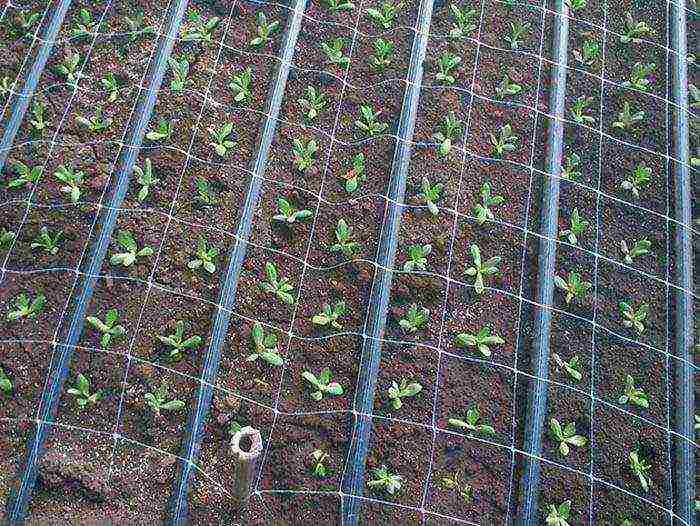
Crops require regular ventilation and removal of accumulated condensate. If the soil is very dry, then it is moistened with a spray bottle with water at room temperature.
Growing eustoma from seed material in a greenhouse is complicated by the plant's exactingness to external conditions, but if all agrotechnical measures are observed, it is quite feasible.
Eustoma seedling care
- The optimum temperature for growing eustoma from seeds is 21-24 ° C. With this temperature regime, seedlings appear on the tenth day. Young seedlings are very small in size, and to grow a strong and sturdy plant requires patience and strict adherence to all agricultural techniques.

- After the appearance of the second true leaf, the eustoma seedlings should be gradually hardened.
- Eustoma grown from seeds is susceptible to black-legged damage. To protect young seedlings from this disease, they should be periodically treated with a phytosporin solution.
- Effectively strengthen seedlings and have a positive effect on growth and development, regular use of epin or zircon.
- When two or three true leaves appear, the seedlings must be dived into separate containers filled with a special soil mixture or flower soil.
Growing eustoma in a greenhouse
Long-term cultivation of eustoma is possible not only in a potted version, but also in greenhouse-type structures. This is a rather complicated process, due to the whimsicality of eustoma to light conditions and the presence of fresh air. Caring for eustoma takes patience and time.
The temperature regime in the greenhouse should be within 22 ° C. It is necessary to regularly ventilate, but avoid strong drafts that can negatively affect the eustoma seedlings.
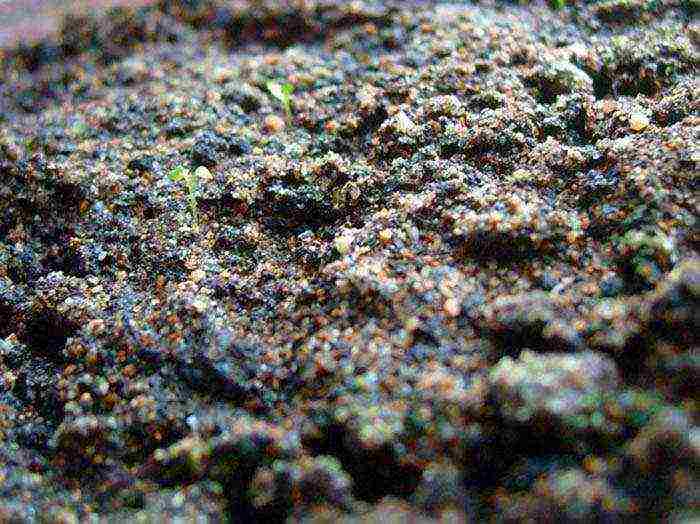
Moderate watering is carried out only with settled and soft water. During intensive growth and flowering, eustoma needs the use of liquid complex fertilizers. In addition, it is required to promptly remove all dried and wilted peduncles.
After flowering, the Irish rose grown in a greenhouse needs to be pruned. However, a few strong internodes should be left in the pruning process. After such a procedure, it is necessary to reduce the temperature in the greenhouse to 12 ° C or transfer the eustoma to a room with the required temperature regime. Rest fertilizing is completely canceled, and the frequency of watering should be significantly limited. With the spring emergence of shoots around the awakened plant, you need to replace the soil and resume the usual care regimen.
We invite you to learn the technology of growing roses in greenhouse conditions.
Care Tips
- A plant grown in indoor or greenhouse conditions does not need to be sprayed. Waterlogging leads to diseases on the leaves.
- For abundant flowering and growth, eustoma requires bright, but diffused lighting.
- Reproduction of eustoma is possible only through seeds.
- The root system of the plant is very vulnerable and does not tolerate transplants well. The optimal soil contains peat and humus of bark at the rate of 1: 1. You can use a special soil mixture for Saintpaulia.
- The flowering period begins four to five months after sowing. In open ground conditions, an eustoma should be allocated a semi-shady place with loose soil and an average degree of moisture capacity.
- Numerous video instructions allow you to grow an eustoma from seeds and decorate your garden with a wonderful flowering plant.
In order not to lose the material, be sure to save it to your social
Attention, only TODAY!
Reviews and comments


